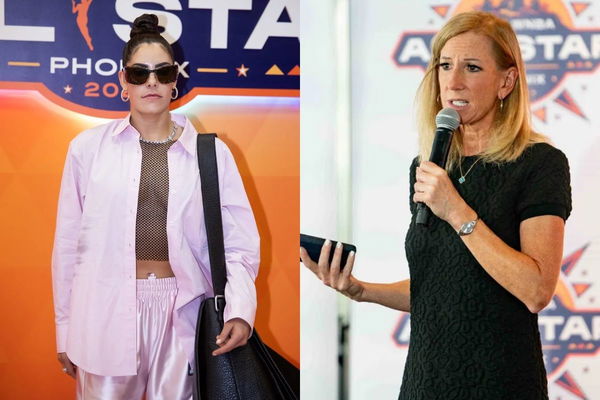
via Imago
WNBA Commissioner Cathy Engelbert speaks during the Changemaker Day event at Parsons Leadership Center at Camp South Mountain in Phoenix on July 18, 2024.

via Imago
WNBA Commissioner Cathy Engelbert speaks during the Changemaker Day event at Parsons Leadership Center at Camp South Mountain in Phoenix on July 18, 2024.
The WNBA has been on a roll lately—viewership is up, attendance soaring, and its stars shining. Rookie sensation Caitlin Clark and veterans like A’ja Wilson have taken the league to new heights, but financial losses are still in the red, albeit better than expected. Things took an interesting twist in October when WNBA players opted out of their current collective bargaining agreement (CBA). It stirred fears of a potential lockout after the 2025 season.
However, now things are looking up. The WNBA and the Women’s National Basketball Players Association (WNBPA) sat down in New York for a preliminary meeting, and the outcome has players and fans breathing a sigh of relief—for now.
Both sides called the discussions “constructive,” with plans to keep the dialogue rolling. Among the big names present were WNBPA President Nneka Ogwumike, First Vice President Kelsey Plum, Vice President Napheesa Collier, CBA Committee Co-chair Satou Sabally, and more.
ADVERTISEMENT
Article continues below this ad
From the WNBA, it was Cathy Engelbert and WNBA Labour Relations Committee members. The official joint statement described the session as “preliminary conversations and constructive dialogue” aimed at a “transformational, new CBA.”
Today, the WNBA and WNBPA released a joint statement regarding a preliminary CBA meeting:
“Today’s meeting included preliminary conversations and constructive dialogue, with a mutual agreement to continue discussions for a transformational, new CBA.” pic.twitter.com/H8ZcnrH8A5— Khristina Williams (@Khristina) December 12, 2024
But why did the CBA opt out in the first place? So, on October 21, just a day after Game 5 of the WNBA Finals, the players dropped a bombshell by announcing their decision to opt out of the current CBA, which originally runs through 2027. Their message was clear how the current terms just don’t cut it anymore. “We’re demanding a CBA that reflects our value,” Ogwumike said.
The league has been growing, but players feel their compensation and benefits haven’t kept up. Right now, the league’s average player salary hovers around $102,000 per year. Add to that outdated family planning policies, limited health benefits, and no retirement plan. Even WNBPA Executive Director Terri Jackson pointed out the irony, “Salaries for coaches and facilities are going up. But not player salaries. Those are capped.”
This push for change hasn’t been without risks. Opting out of the CBA opens the door to a potential lockout if the two sides can’t agree on new terms before the end of the 2025 season. A lockout would mean no games, no income for players, and a massive disruption to the league’s momentum. That’s the nightmare scenario everyone wants to avoid. So, what could this “transformational” new CBA look like?
What’s your perspective on:
Will the WNBA's push for a new CBA transform the league, or lead to a dreaded lockout?
Have an interesting take?
ADVERTISEMENT
Article continues below this ad
A new CBA that could work for everyone
First, a revenue-sharing model could do wonders. Imagine players getting a share of the league’s profits, including expansion fees. It’s a way to make everyone feel invested. Next, a tiered salary structure could help balance the league’s financial realities with players’ demands for higher pay.
Think of it as rewarding performance and experience while keeping things sustainable. And then there are sponsorships. The league’s rising popularity is bound to attract big-name brands, especially with stars like Sabrina Ionescu and Caitlin Clark already pulling in individual deals.

via Imago
Jul 9, 2024; Los Angeles, California, USA; The WNBA logo on the court at Crypto.com Arena. Mandatory Credit: Kirby Lee-Imagn Images
If the league can land more sponsors, it’s a win for everyone. Finally, the league could focus on community outreach to boost attendance and merchandise sales. For now, this week’s meeting has eased fears, and that’s a big win in itself. But the hard work isn’t over yet. Players and officials have until the end of the 2025 season to hammer out a deal. Can they pull it off?
ADVERTISEMENT
Article continues below this ad
ADVERTISEMENT
ADVERTISEMENT
ADVERTISEMENT
ADVERTISEMENT


Will the WNBA's push for a new CBA transform the league, or lead to a dreaded lockout?